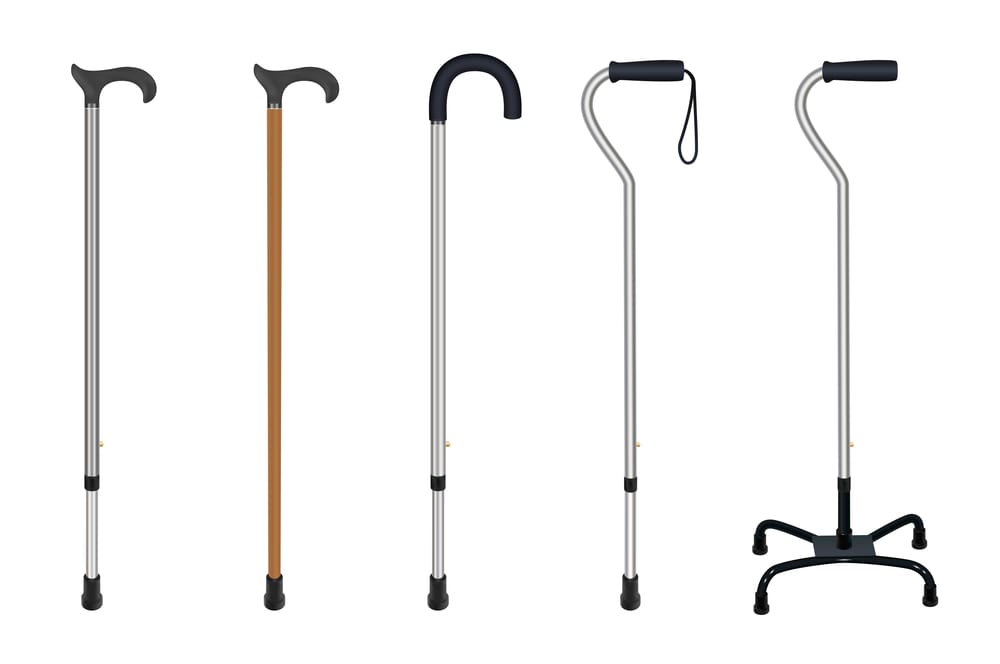Although several people use walking sticks and walking canes, many people might not know the difference between them at first glance. You may ask yourself where yours stands in the walking stick vs cane debate. The main difference is that a walking cane offers more support than a walking stick does. However, there’s a bit more nuance to this.

If you’re asking yourself how these mobility tools differ, how people use them, and what factors matter when choosing either, we may be able to enlighten your curious mind.
Difference Between Cane and Walking Stick
Walking sticks and canes both qualify as a walking aid. They are useful tools for people, particularly the elderly, to travel without putting too much pain and strain on their bodies. Many of them are sturdy enough to support reasonable amounts of weight.
While many may have a similar appearance and help people walk, there is a difference between canes and walking sticks. By delving into these differences about a walking stick vs a cane, you can determine which one you might need more.
About Walking Canes

Walking canes are designed for supporting body weight for people who may have mobility problems, transferring that weight from their legs to their core. Another primary use of a walking cane is to reduce the risk of falling while moving.
Many seniors use canes to improve their posture or reduce pain in their joints, muscles, and back while they walk. It also gives them independence while walking without needing additional assistance.
Canes come in various styles, but share a similar trait of a hook-like handle grip which provides comfort for their users. Some of these models are also retractable or adjustable for convenient storage and portability. These styles include:
- Quad canes
- Offset canes
- Functional grip canes
- “C” canes
Check our picks for best walking canes.
About Walking Sticks

Although some may use the term “walking sticks” interchangeably with “walking canes,” walking sticks are primarily used as accessories or for occasional use. They are more suited for walking on rough or uneven surfaces such as hiking. Many people use them to ascend or descend steep paths without tiring their joints.
They can also use walking sticks to aid them while overcoming obstacles in the wilderness. Some of these solutions include pushing away branches and foliage, testing the depth of mud or water, using it to structure tents or shelter, and scaring away dangerous animals.
Key Difference
Although canes and walking sticks assist with mobility and body support, a crucial difference between the two is their functionality. Canes are more suitable for long-term use and support. They can support more weight than walking sticks because of how frequently someone uses them for daily mobility.
Canes also have a more comfortable grip for long-term use. Walking sticks have more intricate designs for their handles, making them more uncomfortable if someone frequently uses them.
Walking sticks don’t support as much weight as walking canes since they’re designed for short-term mobility or fashion.
Many walking canes have medical insurance coverage due to their frequent use by seniors or people with injuries. In contrast, walking sticks aren’t covered by medical insurance.
Walking Stick or Cane, How to Choose the Right One?
Once you know the differences, you will need to know how to choose between a walking stick or a cane. If you’re looking for one that’s ideal for you, there are several factors you need to consider before choosing one.
Health Condition
Depending on your health condition, some walking sticks or canes may suit you more than others. While joint, back, or ligament pain plays a factor in choosing a cane or stick for mobility support, other conditions may also affect how you choose one for you.
If you don’t have medical conditions, you may be more conditioned to get a walking stick.
Weight
Your weight may also be a deciding factor on the type of cane or stick you get. Typically, a walking cane can support up to 25% of your body weight.
If you need a tool that supports more weight, it would be best to get a walking cane designed for better mobility support. If you decide on getting an adjustable walking cane or stick, it would be wise to find out about its weight restrictions.
If you use a walking cane or stick made with a specific material, including wood, metal, or carbon fiber, its weight support and longevity may vary.
Height
When selecting a walking cane or stick, it is best to find one suitable for your height. If you get a cane in the wrong size, it may make you fall or cause bad posture, leading to pain or discomfort.
A suitable cane or stick length should equate to the approximate length between your wrist and the floor.
If your walking cane has an ideal height, you should be able to bend your elbow at a 15-degree angle comfortably. Some canes and sticks have collapsable or adjustable models, but it would be wise to check if this height adjustability affects how much weight it can support.
Purpose
Your choice for a walking stick or cane may depend on how you want to use it. If you’re concerned about your health and safety while walking, you may prefer buying a walking cane to accommodate your needs.
They provide excellent comfort and strength for long-term use as you walk around your home or outside.
If you want a fashionable and sturdy walking aid for your outdoor trekking, you may find it more suitable to get a walking stick. Walking sticks are ideal for short-term support and come in various shapes for you to collect.
Grip Size
If you want to use a comfortable cane or walking stick, it would be best to find one that fits your hand size. For example, people with larger hands may need a spacious handle for their walking stick or cane that supports more weight than others.
Conclusion
There are several factors to consider when comparing and contrasting walking sticks vs canes. When selecting a walking stick or cane, it is important to pick one that supports your weight, matches your height, and how you want to use it.
Walking sticks are primarily used for short-term mobility assistance for treacherous terrain. In contrast, canes are tools more suited for people to support their bodies independently to decrease strain and prevent falls as they walk.



